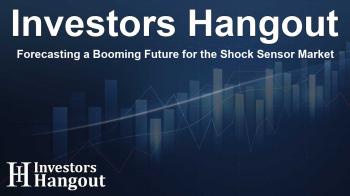Forecasting a Booming Future for the Shock Sensor Market

Shock Sensor Market Size & Price Trends
The shock sensor market is on a robust trajectory, with projections indicating it will ascend from its current valuation to approximately USD 6,504.91 million. This impressive growth forecast highlights the industry's dynamic evolution as it increasingly adapts to technological advancements and consumer needs.
Driving Forces Behind Market Growth
A pivotal force propelling this sector forward is the increasing integration of innovative technologies. Modern shock sensors are now capable of delivering heightened accuracy and enhanced durability, which are vital attributes in applications across automotive, aerospace, and consumer electronics industries. Industries are recognizing that reliable sensors can significantly reduce malfunction risks, a critical factor in product selection.
Reliability and Lifecycle Management
Reliability is paramount as manufacturers prioritize sensor systems that stand the test of time. The lifecycle of these sensors, coupled with their replacement rates, directly impacts market dynamics. Companies are actively seeking long-lasting solutions to mitigate maintenance costs while ensuring continuous operation.
Technological Advancements and Consumer Demographics
Technological progress in materials and Internet of Things (IoT) integration is driving efficiency in the shock sensor market. The improvement in real-time monitoring capabilities is crucial for various industrial applications that require reliable impact detection. The changing customer demographics highlight a substantial rise in demand for these sensors, echoing the wider technology adoption trend across sectors.
Industry Segmentation and Key Drivers
Segments within the market reveal intriguing insights; for instance, the piezoelectric shock sensors currently lead in market share, buoyed by ongoing advancements in sensor technologies and manufacturing processes. On the flip side, the piezo-resistive segment is expected to gain momentum as it showcases potential for significant growth in applications aimed at critical shock detection.
Key Players in the Market
Several key companies continue to make their mark on the shock sensor landscape. Prominent players include TE Connectivity, PCB Piezotronics, and Honeywell. Each of these companies contributes unique sensor types to the market, from piezoelectric to MEMS technologies, ensuring diverse offerings that cater to varied application needs.
Expanding Industrial Applications
Moreover, sectors such as automotive and industrial machinery are increasingly relying on these sensors for safety and efficiency. In automotive applications, shock sensors are integral for stability control and advanced driver assistance systems, bolstering the market’s growth. The industrial sector too stands poised for significant advancements as companies recognize the role of shock sensors in preventing costly machinery damage.
Regional Market Dynamics
The geographical landscape of the shock sensor market is as critical as its technological prowess. North America currently dominates this market share due to a thriving automotive sector driven by innovations in vehicle safety and performance. However, the Asia-Pacific region is emerging as a rapidly expanding market, fueled by the increased demand for automotive technologies and industrial applications in countries like China and Japan.
Future Outlook and Conclusion
Looking towards the future, the shock sensor market presents promising opportunities for growth and innovation. The interconnectivity of technological advancements and increased consumer awareness about safety features in various applications will continue to shape the market landscape.
Frequently Asked Questions
What is the projected market size of the shock sensor market?
The shock sensor market is expected to reach USD 6,504.91 million by 2032.
What factors are driving growth in the shock sensor market?
The growth is largely driven by technological advancements, demand across various industries, and the need for reliable and durable sensors.
Who are the leading companies in the shock sensor market?
Major players include TE Connectivity, PCB Piezotronics, and Honeywell, each offering innovative sensor solutions.
What applications utilize shock sensors?
Shock sensors are widely used in automotive, aerospace, and consumer electronics, focusing on impact detection and safety.
Which region is the fastest growing in the shock sensor market?
Asia-Pacific is currently the fastest growing region, propelled by its booming automotive and industrial sectors.
About The Author
Contact Henry Turner privately here. Or send an email with ATTN: Henry Turner as the subject to contact@investorshangout.com.
About Investors Hangout
Investors Hangout is a leading online stock forum for financial discussion and learning, offering a wide range of free tools and resources. It draws in traders of all levels, who exchange market knowledge, investigate trading tactics, and keep an eye on industry developments in real time. Featuring financial articles, stock message boards, quotes, charts, company profiles, and live news updates. Through cooperative learning and a wealth of informational resources, it helps users from novices creating their first portfolios to experts honing their techniques. Join Investors Hangout today: https://investorshangout.com/
The content of this article is based on factual, publicly available information and does not represent legal, financial, or investment advice. Investors Hangout does not offer financial advice, and the author is not a licensed financial advisor. Consult a qualified advisor before making any financial or investment decisions based on this article. This article should not be considered advice to purchase, sell, or hold any securities or other investments. If any of the material provided here is inaccurate, please contact us for corrections.

